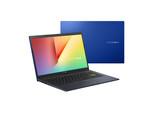Asus VivoBook 14 A413, i5-10210U MX330
Specifications

Price comparison
Average of 3 scores (from 4 reviews)
Reviews for the Asus VivoBook 14 A413, i5-10210U MX330
Source: KL Gadget Guy
 Archive.org version
Archive.org versionFor RM2,899, the ASUS VivoBook 14 does a lot well, particularly in the battery department; unfortunately, its low RAM capacity holds back what the laptop could be capable off with its Intel Core i5-10210U CPU and NVIDIA MX330 GPU. Perhaps for a more well-rounded alternative, I’d say go for the HONOR MagicBook 14, which is cheaper at RM2,299 while offering 8GB RAM, and a capable AMD Ryzen 5 3500U. On the other hand, if you need something great to type on, is super lightweight, has great audio, plus support for Wi-Fi 6 – the VivoBook 14 is a good pick. Visit ASUS’s website here to learn more purchase the laptop.
Single Review, online available, Long, Date: 10/23/2020
Rating: Total score: 70%
Source: Hitech Century
 Archive.org version
Archive.org versionThe ASUS VivoBook 14 A413 is an entry level 14-inch ultraportable with specifications sufficient for everyday general computing with fair performance in all areas. You’re getting a workhorse that can get your coursework done, your spreadsheets and emails sorted and let you browse the web, catch Netflix and otherwise stay connected in the new normal.
Single Review, online available, Long, Date: 09/21/2020
Rating: Total score: 70% price: 70% performance: 70% display: 70% mobility: 60% workmanship: 70%
Source: NLT
 Archive.org version
Archive.org versionPersonally, I’ll suggest you to add RM300 more and get the VivoBook S15 S533 instead at RM3,199. That laptop comes with an IPS LCD screen, better build quality, and 8GB RAM – but also soldered and also MX250 instead of MX330.
Single Review, online available, Medium, Date: 09/21/2020
Source: Pokde
 Archive.org version
Archive.org versionThe ASUS VivoBook 14 A413 looks like a promising ultraportable productivity laptop at first glance. You get a 10th Gen Intel Core CPU with MX330 discrete GPU, 512GB NVMe SSD, Wi-Fi 6, and good looks at a rather affordable price.
Single Review, online available, Very Long, Date: 09/21/2020
Rating: Total score: 72% price: 65% performance: 65% mobility: 85% workmanship: 85%
Comment
NVIDIA GeForce MX330: Successor of the MX230 and most likely a renamed GeForce MX250/MX150 based on the Pascal GP108 chip with 384 shaders and a 64 Bit memory bus for GDDR5.
Modern games should be playable with these graphics cards at low settings and resolutions. Casual gamers may be happy with these cards.
» Further information can be found in our Comparison of Mobile Graphics Cards and the corresponding Benchmark List.
i5-10210U: Comet Lake based low power quad-core processor (technically identical to Whiskey Lake and still produced in 14nm++). The CPU cores can clock between 1.6 and 4.2 GHz (all 4 cores 3.9 GHz max.) with HyperThreading (8 threads). The integrated memory controller supports LPDDR4-2933 and using cTDP up/down the performance can be adjusted by the OEM (10 - 25 Watt possible, 15W default). Compared to the faster i5-10510U, the level 3 cache was reduced from 8 to 6 MB.» Further information can be found in our Comparison of Mobile Processsors.











